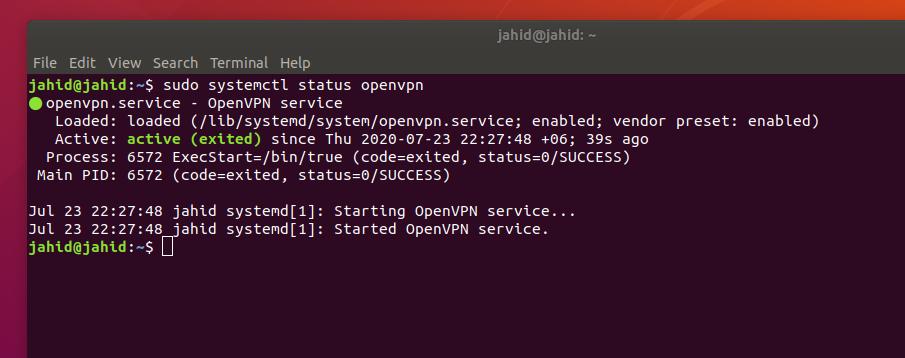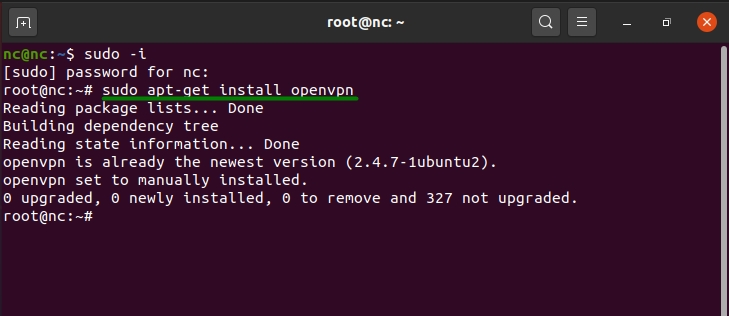

- #RUN OPENVPN WITH SUDO WITHOUT PASSWORD FULL#
- #RUN OPENVPN WITH SUDO WITHOUT PASSWORD PLUS#
- #RUN OPENVPN WITH SUDO WITHOUT PASSWORD SERIES#
Rw: cd-r,cd-rw,dvd-r,dvd-ram state: running Optical-1: /dev/sr0 vendor: hp model: CDDVDW SH-216DB rev: HH20įeatures: speed: 40 multisession: yes audio: yes dvd: yes ID-3: /dev/sdc type: USB model: USB DISK 2.0 size: 14.48 GiB

ID-2: /dev/sdb type: USB model: USB DISK 2.0 size: 14.48 GiB
#RUN OPENVPN WITH SUDO WITHOUT PASSWORD PLUS#
ID-1: /dev/sda model: SSD PLUS 480GB size: 447.13 GiB
#RUN OPENVPN WITH SUDO WITHOUT PASSWORD FULL#
IF: enp3s0 state: up speed: 100 Mbps duplex: full mac: Vendor: Hewlett-Packard driver: r8169 v: 2.3LK-NAPI port: e000 Vendor: Hewlett-Packard AR9485/HB125 802.11bgn 1×1 Wi-Fi driver: ath9kĭevice-2: Realtek RTL8111/8168/8411 PCI Express Gigabit Ethernet Vendor: Hewlett-Packard driver: snd_hda_intel v: kernel bus ID: 00:1b.0ĭevice-2: Intel type: USB driver: hid-generic,snd-usb-audio,usbhidĭevice-1: Qualcomm Atheros AR9485 Wireless Network Adapter

#RUN OPENVPN WITH SUDO WITHOUT PASSWORD SERIES#
OpenGL: renderer: Mesa DRI Intel Haswell v: 4.5 Mesa 19.0.2ĭevice-1: Intel 8 Series/C220 Series High Definition Audio Vendor: Hewlett-Packard driver: i915 v: kernel bus ID: 00:02.0ĭisplay: x11 server: X.Org 1.19.6 driver: modesetting unloaded: fbdev,vesa Speed: 1297 MHz min/max: 800/3400 MHz Core speeds (MHz): 1: 1297 2: 1297ĭevice-1: Intel 4th Generation Core Processor Family Integrated Graphics

Topology: Dual Core model: Intel Core i3-4130 bits: 64 type: MT MCPįlags: lm nx pae sse sse2 sse3 sse4_1 sse4_2 ssse3 vmx bogomips: 27138 Type: Desktop System: Hewlett-Packard product: 500-336 V: 7.4.0 Desktop: Cinnamon 4.0.10 Distro: Linux Mint 19.1 Tessa Host: xxxxxxxx Kernel: 4.15.0-55-generic x86_64 bits: 64 compiler: gcc If you import your VPN provider's server configuration file (somewhere.ovpn) into your Network Manager, then you can easily connect to their VPN servers without using "sudo" root superuser commands or using the console terminal.Īnd after importing at least one of your VPN provider's server location's configuration file, if you edit your local ISP (Internet Service Provider's (wired or wireless) connection through the Network Manager (NM) and click the "General" tab, you can select a default VPN server location to automatically connect with whenever you boot up or login to your Linux Mint system. (Solved)PrivateTunnel Questions - Linux Mint Forums If you import your VPN provider's server configuration file (somewhere.ovpn) into your Network Manager, then you can easily connect or disconnect to their VPN servers using (clicking) your Network Manager icon in the system tray without using "sudo" root superuser commands or using the console terminal.Īnd after importing at least one of your VPN provider's server location's configuration file into you Network Manager (NM), if you edit your local ISP (Internet Service Provider's (wired or wireless) connection through the Network Manager (NM) and click the "General" tab, you can select a default VPN server location to automatically connect with whenever you boot up or login to your Linux Mint system. If you run " inxi -Fxzd" and " lsusb" from the console terminal prompt, highlight the results, copy and paste them back here, that should provide enough information. It would help to know more about your system setup.


 0 kommentar(er)
0 kommentar(er)
